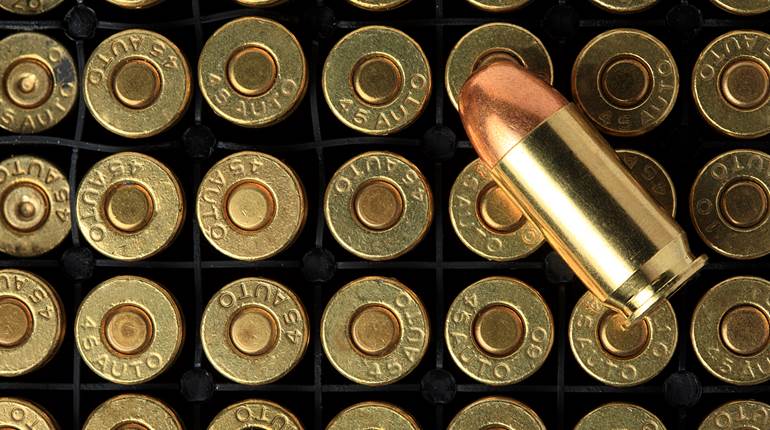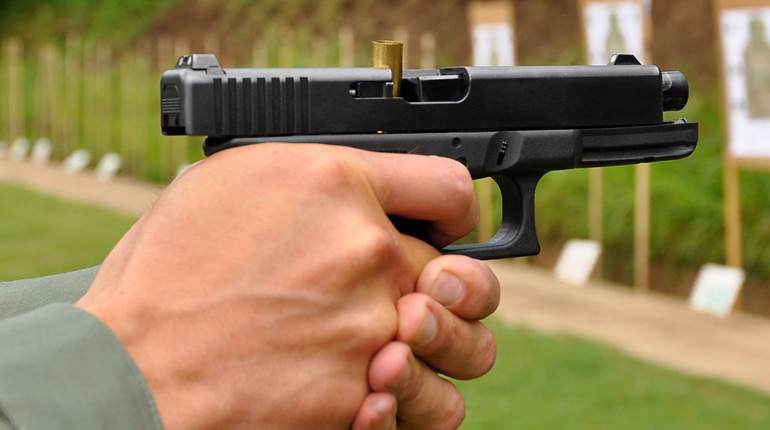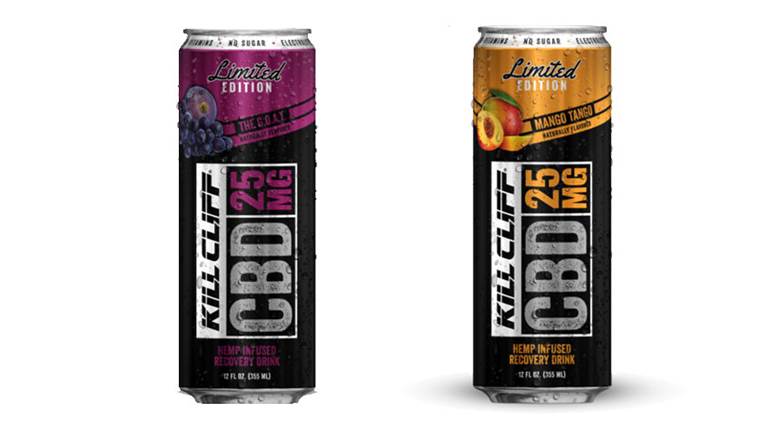
I’ll never forget the first time I shot a .45-cal. handgun. I had just started shooting, and was at an indoor range happily plinking away with my brand-new Ruger Mark III Hunter .22 pistol. One of the guys that worked there, a hulking mass of a fellow, handed me a different pistol and said, “Here—shoot this.” I asked him what kind of handgun it was, and he wouldn’t tell me. So, I pointed downrange, and squeezed the trigger. BOOM! I turned and yelled at him, “I can’t shoot this gun! Take it back!” He yelled back at me to keep shooting. So I did, emptying the magazine.
When we retrieved the target, we saw I managed to hit it a few times, but my shot pattern was all over the place. Turns out he was a retired Green Beret, and he told me he always starts his students on a .45, then works their way down to a .22. “That way, they can handle any caliber firearm,” he said. Then he taught me a very important lesson. “If you work out, and build up your arm and grip strength, you’ll shoot better, and you can shoot anything you want.” Turns out ... he was right.
According to Shooting Sports USA and other experts in the field, shooters who are involved in a regular physical fitness program may enjoy the following benefits:
- Improved accuracy with superior control of a firearm
- Extended stamina and endurance for hunts and matches
- Increased ability to handle stress in competition, or in a panic situation
Here are some exercise and nutrition tips to help you become a better shooter, whether for recreation, self-defense, or competition. (NOTE: Check with your doctor before embarking on a physical fitness program, especially if you haven’t exercised in a while.)
Start with your core. “Shooters should focus on strengthening their core muscles, which are the muscles around your trunk and pelvis, to improve balance and stability,” says Robert Herbst, certified personal trainer, 19-time world power-lifting champion, and 34-time national champion. “Increased stability leads to increased accuracy, whether you’re shooting a 10-lb. rifle or a 2-lb. pistol.”
To strengthen your core muscles, do an exercise called “The Plank”:
-Lie on your stomach with your arms next to your sides.
-Raise yourself up so that you're resting on your forearms, and clench your fists.
-Point your toes into the mat.
-Place your shoulders directly above your elbows.
-Tighten your abs as if you are about to be punched in the stomach. Your body should be in as straight a line as possible, horizontal to the floor.
-Hold for 30 seconds.
-Return to the start position and repeat.
Strengthen the legs. “Shooters need to be able to stand steady while holding their firearm, so strong legs are a must,” says Herbst. “To get strong legs fast, choose exercises such as high-rep squats and lunges. As an added bonus, these exercises will also work the core to give you strength and stability when holding a firearm.”
To do a squat, stand with your feet slightly greater than shoulder width apart and your toes pointing ahead. Slowly descend, bending through the hips, knees and ankles. Stop when your knees reach a 90-degree angle. Then return to the starting position. Repeat 12 times. 
Stabilize those shoulders. “One of the most important fitness tips for shooters is to work on their shoulder stabilizer muscle strength,” says Leon Turetsky, certified personal trainer, and corrective exercise specialist. “In order for shooters to have a steady arm while shooting, their shoulder muscles need to be in tip-top shape.”
According to Turetsky, the main muscles involved here are the rotator cuff and deltoids. The rotator cuff muscles are a group of four muscles in and around the shoulder and shoulder blade area. Their main function is to stabilize the shoulder joint. Deltoid muscles form the rounded contour of the shoulder. “In shooting, they would be responsible for providing support to the arm holding the gun,” notes Turetsky. 
Here are two great exercises to activate and strengthen the rotator cuff and deltoid muscles:
Exercise #1: External Rotation with a Band
- Attach a resistance band to a doorknob, or something that doesn’t move.
- Hold the other end of the resistance band in one hand (with tension), with shoulder internally rotated.
- Externally rotate the arm and shoulder (tension increases).
- Repeat 10 times on each arm and do 2 sets.
Exercise #2: Supraspinatus exercise
- Hold 2 low-weight dumbbells in both hands
- Externally rotate the arms so the thumbs point up.
- Slowly raise both arms to just below shoulder height
- Repeat 12 times and do 2 to 3 sets
Get a grip. A strong grip and forearm will help provide a stable platform for shooting, resulting in increased accuracy. A gun’s recoil energy has to go somewhere, and if you have a strong lower arm, you should have better recoil absorption, more control of the firearm, and aim better. You should also have stronger gun retention—in other words, if someone tries to take your gun away from you, you will have a greater chance of holding on to your firearm for self-defense.
Follow these tips from certified personal trainer Jason Priest:
Purchase a gripper. “They are fairly inexpensive and can be purchased at most sporting good stores,” says Priest. “Do three sets of 10 reps each day, increasing the number of reps until you run out of strength.” Other products include Fat Gripz, Captains of Crush Grippers, and hand bands. You can also squeeze a tennis or racquetball.
Practice reverse curls. “Stand while holding a barbell at shoulder width with your elbows close to your torso, and your feet shoulder-width apart,” says Priest. “The palm of your hands should be inward, facing your body. Keep your upper arms stationary, and bring up the barbell, curling and contracting the biceps, and exhale.”
Go long. To increase stamina and endurance for those day-long hunts and three-day matches, follow these tips from certified personal trainer Franklin Antoian:
“A good range-ready tune-up would be to participate in some form of aerobic exercise, such as walking, for at least 30 minutes a day, five days a week,” says Antoian. “This will provide heart-healthy benefits, and improve your shooting thanks to overall fitness.” To increase stamina, Antoian suggests to increase the amount of reps that you do per exercise by 20 percent, and decrease rest time between exercises. “You can also add a cross-training cardio program, such as an additional 15 minutes on the treadmill, 15 minutes on an elliptical, or 15 minutes on a rowing machine.”
Aim for lean protein and fiber. “Food is fuel,” notes Elliot Beadle, sports dietician with Sodexo at Lehigh Valley Health Network. “If you put high-quality fuel in your tank, you’re going to get good performance out of it.” Protein helps build muscle tissue, and keeps your energy level on an even keel throughout the day. High-fiber foods have cardiovascular benefits, such as reducing blood pressure and inflammation. Dietary fiber also helps control blood sugar levels.
Beadle suggests dividing your plate into the following categories: ¼ plate of lean protein, ½ plate of veggies or fruit, and ¼ plate of whole grains. “What’s key here is consistency,” he notes. “You don’t want to drastically change your routine on the day of competition. You want it to be a habit as far as what you’re eating, and when. If you change your diet on the day of a match or hunt, you could upset your system.” 
Crunch on carrots. “In regard to shooting sports, eye health is crucial,” says Emily Wargo, clinical dietician, St. Luke’s University Health Network. “Vitamin A has been proven to aid against macular degeneration and cataracts. It has also been shown to play a role in maintaining clear corneas, and is a component of rhodopsin, a protein that assists in better sight in low-light conditions.” Other nutrients that support healthy vision include lutein and zeaxanthin. Great sources of these nutrients include carrots, sweet potatoes, spinach, kale, pumpkin, and green peppers.
Drink up! W.C. Fields once said, “Let us drink with impunity ... Or anyone else who’s buying!” He’d be disappointed to hear we’re talking about water here. “If you’re shooting outside all day in the summer, water is key for adequate hydration,” says Wargo. “Try to overhydrate before a match, because if you become dehydrated, it can take up to 12 hours to fully rehydrate.” Wargo suggests 11 cups of water daily for women, and 15 cups a day for men.
Maureen Sangiorgio is an NRA-Certified Firearms Instructor/RSO, and an award-winning writer.
Top image copyright NRA/AmericanRifleman.org






































